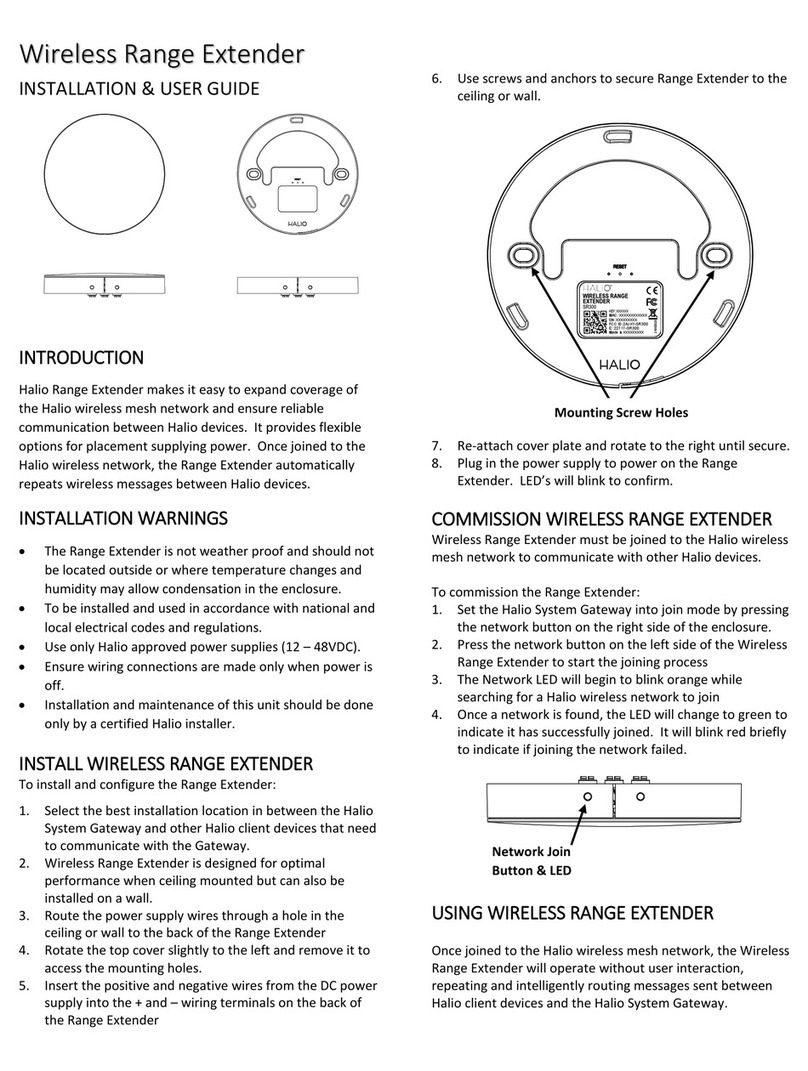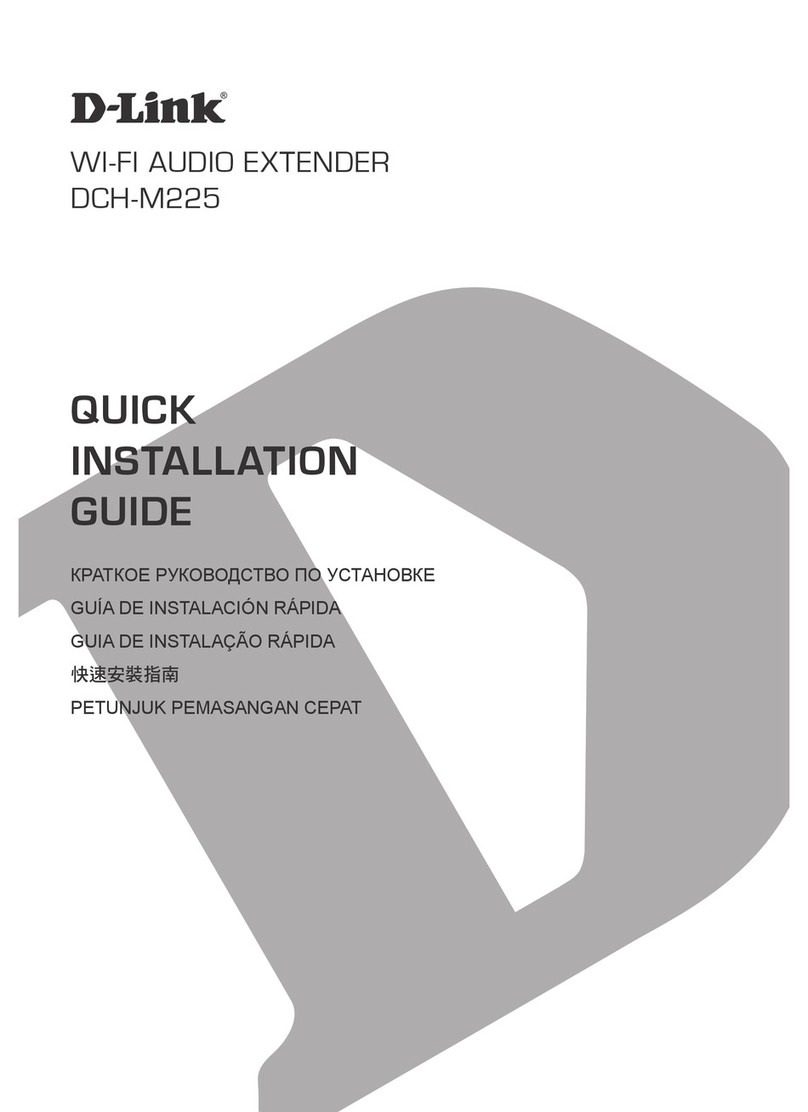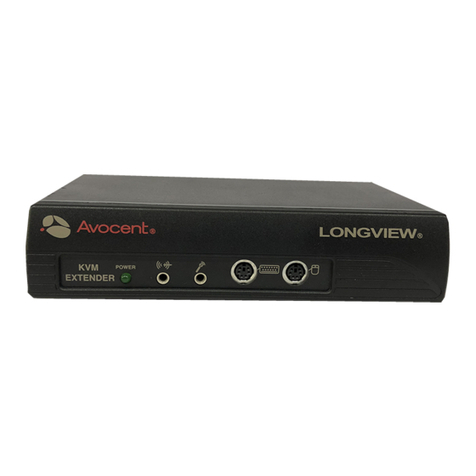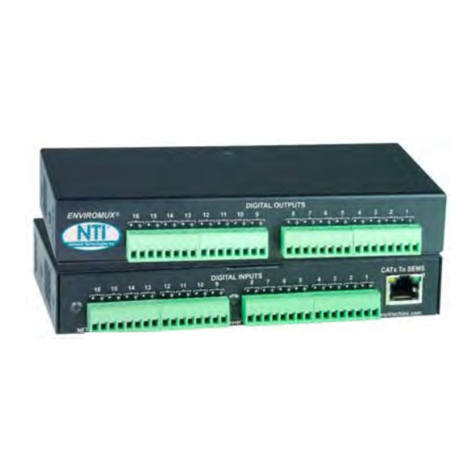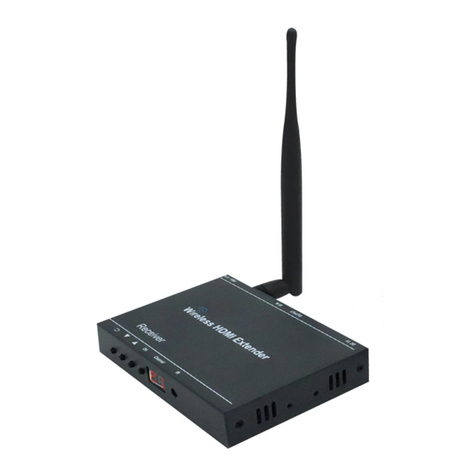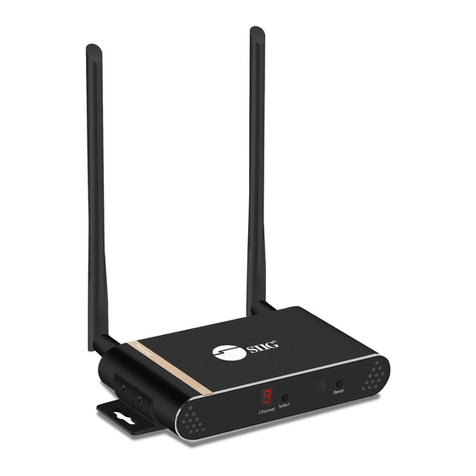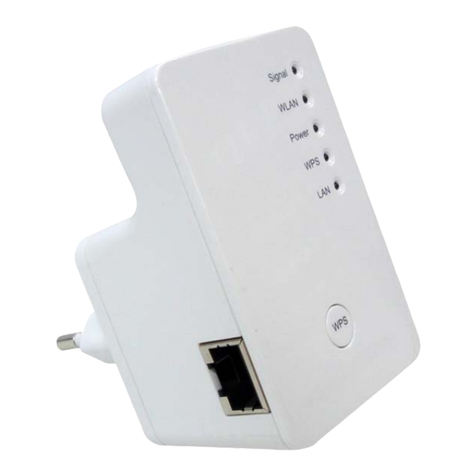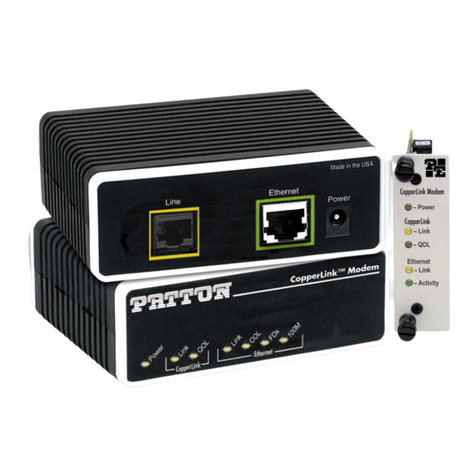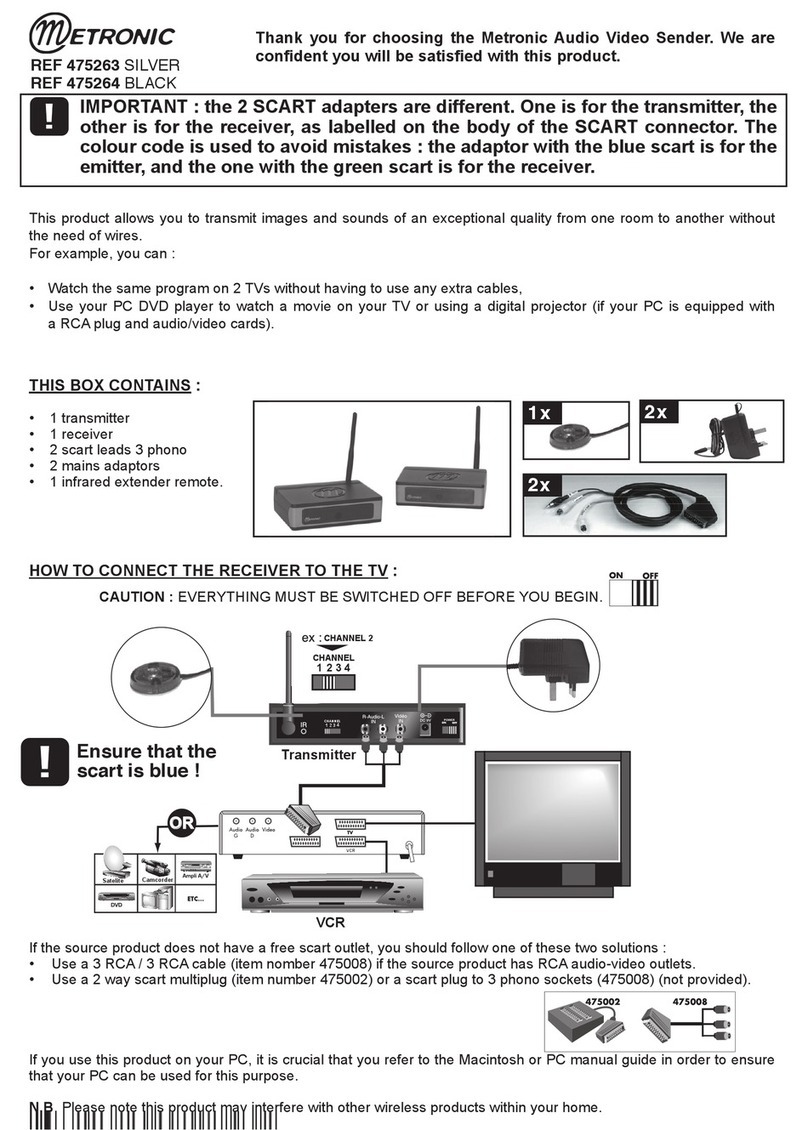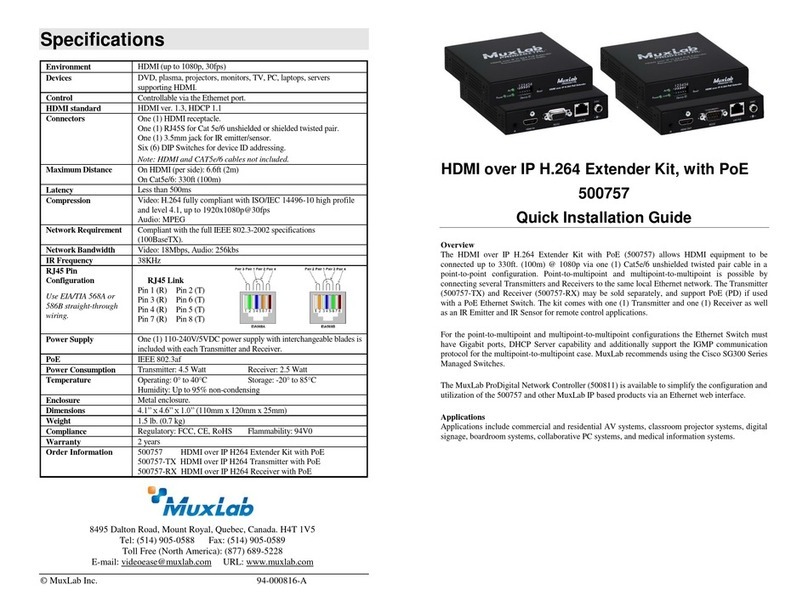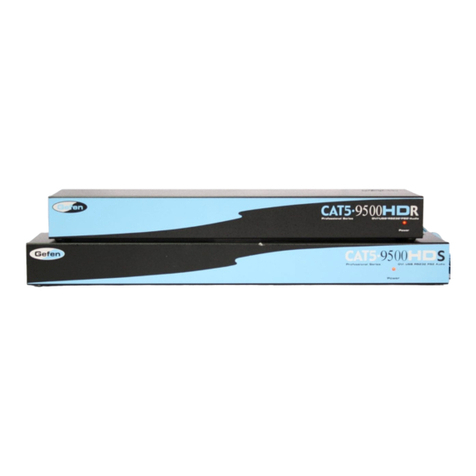Metrodata WCM1400 BNC User manual

WCM1400
WCM1800
WCM1820
Managed Ethernet Extender
V8
Quick Start Guide
DATE: 2nd April 2012
DOCUMENT NO: 76-02-087
REVISION: D
PREPARED BY: Ian Banbrook
Metrodata Ltd
Fortune House, Crabtree Office Village
Eversley Way, Egham Surrey, TW20 8RY, UK
Tel +44 1 784 744700
Fax: +44 1 784 744730
E-Mail: [email protected]o.uk

METRODATA LTD WCM1400/WCM1800/WCM1820
Quick Start Guide
76-02-087 Rev D
2 of 61
METRODATA LTD
No part of this publication may be reproduced, transmitted,
transcribed, stored in a retrieval system, or translated into any
language or computer language, in any form or by any means,
electronic, mechanical, magnetic, optical, chemical, manual or
otherwise, without the prior written permission of
Metrodata Ltd, Fortune House,
Crabtree Office Village, Eversley Way,
Egham, Surrey, TW20 8RY, United Kingdom.
DISCLAIMER
Metrodata Ltd makes no representations or warranties with respect
to the contents hereof and specifically disclaims any implied
warranties or merchantability or fitness for any particular purpose.
Further, Metrodata Ltd reserves the right to revise this publication
and to make changes from time to time in the content hereof without
obligation of Metrodata Ltd to notify any person of such revision or
changes.
Copyright 2012 by Metrodata Ltd,
All Rights Reserved

METRODATA LTD WCM1400/WCM1800/WCM1820
Quick Start Guide
76-02-087 Rev D
3 of 61
Document Revision History
28th January 2011 XA Document Created
18th February 2011 XB Document Updated
25th March 2011 A Document Released
8th July 2011 B Updated for new OAM screens
4th November 2011 C Updated VLAN trunking
2nd April 2012 D Updated for V8 software release

METRODATA LTD WCM1400/WCM1800/WCM1820
Quick Start Guide
76-02-087 Rev D
4 of 61
TABLE OF CONTENTS
1INTRODUCTION..........................................................................................................7
1.1 Product Rear Panels...........................................................................................................................................8
1.1.1 WCM1820 RJ45 Rear Panel...........................................................................................................................8
1.1.2 WCM1820 BNC Rear Panel............................................................................................................................8
1.1.3 WCM1800 RJ45 Rear Panel............................................................................................................................8
1.1.4 WCM1800 BNC Rear panel............................................................................................................................9
1.1.5 WCM1400 RJ45 Rear panel............................................................................................................................9
1.1.6 WCM1400 BNC Rear Panel............................................................................................................................9
2WCM1800 APPLICATIONS.......................................................................................10
2.1 WCM1800 Normal Mode.................................................................................................................................10
2.2 WCM1800 VLAN Trunk Mode......................................................................................................................10
2.3 WCM1800 VLAN Access Mode......................................................................................................................11
2.4 WCM1800 S-Tag Mode ...................................................................................................................................11
2.5 Point to Multi-Point..........................................................................................................................................12
3THEORY OF OPERATION ........................................................................................13
3.1 Frame Encapsulation .......................................................................................................................................13
3.2 Virtual Concatenation and LCAS...................................................................................................................14
4QUICK START CONFIGURATION............................................................................15
4.1 Access the WCM1800.......................................................................................................................................15
4.2 Logging onto WCM1800..................................................................................................................................15
4.2.1 User Interface Navigation..............................................................................................................................16
4.3 Configure the WAN interface..........................................................................................................................17
4.4 Configure the VCAT Group............................................................................................................................18
4.5 Set IP Address...................................................................................................................................................20
4.6 Set Default Route..............................................................................................................................................21
4.7 Save the Configuration.....................................................................................................................................22
5ADVANCED CONFIGURATION................................................................................23
5.1 System Configuration.......................................................................................................................................23
5.1.1 Setting the Time and Date .............................................................................................................................24
5.1.2 Setting the Node Name..................................................................................................................................24
5.1.3 Setting the Password......................................................................................................................................25
5.1.4 ‘View’ User ...................................................................................................................................................25

METRODATA LTD WCM1400/WCM1800/WCM1820
Quick Start Guide
76-02-087 Rev D
5 of 61
5.1.5 Welcome Screen............................................................................................................................................26
5.1.6 Warm Start.....................................................................................................................................................29
5.1.7 Cold Start.......................................................................................................................................................29
5.2 Configuration of the Data Ports......................................................................................................................30
5.2.1 LAN Port .......................................................................................................................................................31
5.2.1.1 State......................................................................................................................................................31
5.2.1.2 Link Status ...........................................................................................................................................31
5.2.1.3 Auto Negotiation..................................................................................................................................31
5.2.1.4 Speed....................................................................................................................................................32
5.2.1.5 Duplex..................................................................................................................................................32
5.2.1.6 Negotiated............................................................................................................................................32
5.2.1.7 MDI/MDIX..........................................................................................................................................32
1.1.1.1 Counters...............................................................................................................................................33
5.2.1.8 Traffic Management.............................................................................................................................33
5.2.1.8.1 Traffic Type.....................................................................................................................................34
5.2.1.8.2 Port Type.........................................................................................................................................34
5.2.1.8.3 VLAN/S-Tag ID..............................................................................................................................34
5.2.1.8.4 default Priority.................................................................................................................................35
5.2.1.9 OAM....................................................................................................................................................35
5.2.2 WAN Port......................................................................................................................................................36
5.2.2.1 State......................................................................................................................................................37
5.2.2.2 Interface ...............................................................................................................................................37
5.2.2.3 Timing..................................................................................................................................................37
5.2.2.4 RX Sensitivity......................................................................................................................................37
5.2.2.5 Framing................................................................................................................................................37
5.2.2.6 CRC-4 ..................................................................................................................................................38
5.2.2.7 sigNalling.............................................................................................................................................38
5.2.2.8 VCG.....................................................................................................................................................38
5.2.3 SFP Port.........................................................................................................................................................39
5.2.3.1 SFP Type..............................................................................................................................................39
5.2.3.2 State......................................................................................................................................................39
5.2.3.3 Link State.............................................................................................................................................39
5.2.3.4 Speed....................................................................................................................................................40
5.2.3.5 Auto Negotiation..................................................................................................................................40
5.2.3.6 Negotiated............................................................................................................................................40
5.2.3.7 SFP Info ...............................................................................................................................................40
5.2.3.8 Counters...............................................................................................................................................41
5.2.3.9 Traffic Management.............................................................................................................................41
5.2.3.9.1 Traffic Type.....................................................................................................................................42
5.2.3.9.2 Port Type.........................................................................................................................................42
5.2.3.9.3 VLAN/S-Tag ID..............................................................................................................................42
5.2.3.9.4 default Priority.................................................................................................................................43
5.2.3.10 OAM....................................................................................................................................................43
5.2.4 VCG ( VCAT Group Configuration )............................................................................................................44
5.2.4.1 State......................................................................................................................................................45
5.2.4.2 Encapsulation.......................................................................................................................................45
5.2.4.2.1 Encapsulation..................................................................................................................................45
5.2.4.2.2 GFP FCS .........................................................................................................................................45
5.2.4.2.3 Strip MAC FCS...............................................................................................................................46
5.2.4.2.4 Payload Scrambler...........................................................................................................................46
5.2.4.2.5 Flow Control ...................................................................................................................................46
5.2.4.2.6 Max Frame Size ..............................................................................................................................46
5.2.4.2.7 Priority Table...................................................................................................................................46
5.2.4.3 LCAS/VCAT .......................................................................................................................................47
5.2.4.4 WAN Allocation .................................................................................................................................. 47
5.2.4.5 Traffic Management.............................................................................................................................48
5.2.4.5.1 Traffic Type.....................................................................................................................................48
5.2.4.5.2 Port Type.........................................................................................................................................48

METRODATA LTD WCM1400/WCM1800/WCM1820
Quick Start Guide
76-02-087 Rev D
6 of 61
5.2.4.5.3 VLAN/S-TAG Allocation...............................................................................................................49
5.2.4.5.4 Control VLAN.................................................................................................................................49
5.2.4.5.5 Control S-TAG................................................................................................................................49
5.2.4.6 OAM....................................................................................................................................................49
5.2.4.7 Counters...............................................................................................................................................50
5.2.5 Traffic Isolation.............................................................................................................................................51
5.2.5.1 Isolation Mode .....................................................................................................................................51
5.2.5.2 QinQ Ethertype ....................................................................................................................................51
5.2.5.3 Untagged To.........................................................................................................................................52
5.3 Global Status Screen ........................................................................................................................................53
5.3.1 State...............................................................................................................................................................53
5.3.2 Alarms ...........................................................................................................................................................53
5.4 Proxy Mode Remote Management..................................................................................................................54
5.5 SNMP Management.........................................................................................................................................56
5.5.1 Read/Write/Trap Community........................................................................................................................56
5.5.2 Contact Person...............................................................................................................................................56
5.5.3 Node Name....................................................................................................................................................56
5.5.4 Location.........................................................................................................................................................57
5.5.5 Managers .......................................................................................................................................................57
5.6 Saving the Configuration.................................................................................................................................58
6TFTP SOFTWARE UPDATE .....................................................................................59
6.1 TFTP Configuration.........................................................................................................................................59
6.1.1 Client Mode...................................................................................................................................................59
6.1.2 Server Mode ..................................................................................................................................................60
7ALARMS ....................................................................................................................61
7.1 WAN E1 Port....................................................................................................................................................61
7.2 LAN Port...........................................................................................................................................................61
7.3 SFP Port............................................................................................................................................................61
7.4 VCG...................................................................................................................................................................61

METRODATA LTD WCM1400/WCM1800/WCM1820
Quick Start Guide
76-02-087 Rev D
7 of 61
1 INTRODUCTION
This manual details the basic information required to configure and operate the Metrodata
WCM1400, WCM1800 and WCM1820 family of Products. The product range allows the
extension of Ethernet Services over multiple, bonded E1 Wide Area Network Connections.
The WCM1400 provides 4 E1 ports, giving an uplink capacity of approximately 8Mbps.
The WCM1800 provides 8 E1 ports giving a maximum uplink bandwidth of approximately
16 Mbps, and the WCM1820 provides 16 E1 ports giving a maximum uplink bandwidth of
32Mbps.
Throughout the document WCM1800 will be used, however this manual equally applies to
the WCM1400 and WCM1820.
The WCM1800 performs GFP frame encapsulation and uses Virtual Concatenation
(VCAT) to bond multiple E1 circuits together according to ITU-G.7043 with ITU-G.7042
LCAS to allow for the addition or removal of circuits. Internal packet buffers enable the
WCM1800 to smooth out bursty traffic and prevent packet loss as the higher layer
protocols rate adapt to the bonded E1 capacity. The E1 ports operate in framed mode
using G.704 with CRC-4 multi frame enabled. The WCM1800 range offers upto 4 VCAT
groups (VCG) allowing for upto 4 remote devices to be connected.
The WCM1800 is a managed unit allowing for the effective demarcation between LAN and
WAN services. Management of the WCM1800 is achieved using either Telnet or SNMP
via either the LAN or WAN ports.
The Metrodata WCM1800 is a manageable multiport Ethernet Switch with a multiple,
bonded E1 uplink. The WCM1800 provides two 10/100/1000BaseT Auto Negotiating,
Auto-Switching RJ45 Ports as well as a single SFP port supporting either 1000Base-X or
100Base-FX SFP modules. The WCM1800 operates as a layer 2 bridge and as such may
be used to extend a LAN segment over a WAN link.
The WCM1800 has an internal LAN switch offering full wire-speed switching between
ports. The WCM1800 uses MAC address filtering to filter all local traffic and only forward
traffic destined for remote stations. Each of the WCM1800’s LAN ports support automatic
cross-over switching and will therefore connect directly to a Hub/Switch/Router or PC End
Station.
The WCM1800 has support for both tagged and untagged frames, with both VLAN C-Tag,
and Provider Bridge S-Tag (QinQ) modes supported.

METRODATA LTD WCM1400/WCM1800/WCM1820
Quick Start Guide
76-02-087 Rev D
8 of 61
The WCM1800 supports either IP DSCP, or IEEE802.1p based traffic prioritisation with
outgoing traffic being queued in one of four priority queues.
The WCM1800 supports link OAM, IEEE802.3ah and RSTP for loop prevention.
1.1 Product Rear Panels
The following sections show the rear panels of the various products, all of which are in a
standard 19”, 1U form factor, except the 1820 BNC which requires 2U due to the BNC
connectors.
1.1.1 WCM1820 RJ45 Rear Panel
1.1.2 WCM1820 BNC Rear Panel
1.1.3 WCM1800 RJ45 Rear Panel

METRODATA LTD WCM1400/WCM1800/WCM1820
Quick Start Guide
76-02-087 Rev D
9 of 61
1.1.4 WCM1800 BNC Rear panel
1.1.5 WCM1400 RJ45 Rear panel
1.1.6 WCM1400 BNC Rear Panel

METRODATA LTD WCM1400/WCM1800/WCM1820
Quick Start Guide
76-02-087 Rev D
10 of 61
2 WCM1800 Applications
2.1 WCM1800 Normal Mode
In this application, the WCM1800 is operating with Traffic Isolation Disabled. In this mode,
the WCM1800 acts as a simple, layer 2, 5 port switch with packets being switched based
on MAC address alone. The WCM1800 supports both local and remote switching.
Management traffic is not isolated from the through data traffic, and both units may be
managed from any port.
The WAN link comprises 8 E1 circuits running E1 G.704 CRC-4 framing with GFP packet
encapsulation and VCAT/LCAS to give a combined trunk bandwidth of 15.87Mbps for
payload. In this mode, the untagged frames are directed to VCG1.
2.2 WCM1800 VLAN Trunk Mode

METRODATA LTD WCM1400/WCM1800/WCM1820
Quick Start Guide
76-02-087 Rev D
11 of 61
In this application, WCM1800-A is connected to a VLAN enabled LAN switch. The LAN
switch is configured as a VLAN trunk and all packets are tagged with VLAN Tags.
WCM1800-A is operating with VLAN support disabled, but with a VLAN ID allocated to the
Manager. In this way, the management VLAN, in this case 101, can be used to manage
the WCM1800. WCM1800-B is configured with VLAN support enabled and thus each port
is isolated to a single VLAN.
2.3 WCM1800 VLAN Access Mode
In this mode, both WCM1800 units have VLAN support enabled. VLAN 101 is used as the
management VLAN and in unit WCM1800-A the VLAN group 101 includes the LAN Port 1,
the Manager and the E1 port. At the remote end, Port 1 is disabled to prevent customer
access to the WCM1800 manager.
2.4 WCM1800 S-Tag Mode
In this mode, the WCM1800 adds a, port based, S-TAG to all incoming traffic. Where
customer traffic is already VLAN tagged, this leads to double tagging or ‘QinQ’ operation.
The use of the S-TAG enables the carrier to isolate customer traffic. Carrier management
traffic is carried with a separate S-Tag giving management access to both units, and on
the customer site the external management access is disabled.

METRODATA LTD WCM1400/WCM1800/WCM1820
Quick Start Guide
76-02-087 Rev D
12 of 61
2.5 Point to Multi-Point
In this application, the traffic is transported to remote destinations based on the incoming
VLAN C-Tag. To support the point to multipoint management, the IP Proxy mode is used
with device A acting as the server and B/C acting as clients.
In this application, WCM1800-A is operating with VLAN mode enabled and is operating
LAN Port 2 in VLAN Trunk Mode. Incoming packets must be tagged and are switched
based on the incoming tag. Individual VLAD ID’s or ranges may be allocated to each
VCG. In this case, VLAN 101 and 102 are allocated to VCG1 serving remote device B,
whilst VLAN 103, 104 are allocated to VCG2 serving remote device C.
The remote devices, B and C are both operated in VLAN mode but with the LAN ports in
access mode stripping the tags from egress packets and tagging packets on ingress.

METRODATA LTD WCM1400/WCM1800/WCM1820
Quick Start Guide
76-02-087 Rev D
13 of 61
3 Theory of Operation
3.1 Frame Encapsulation
The WCM1800 uses the Generic Framing Procedure (GFP) to encapsulate the Ethernet
frames for transmission over the WAN link(s). GFP is a byte aligned procedure and hence
is suitable for use with multi link bonding. GFP does not use bit stuffing as with HDLC and
is therefore a deterministic protocol. The diagram below compares HDLC and GFP for
encapsulation of an Ethernet Frame
The native Ethernet frame is encapsulated under GFP as shown.
The GFP core header is four bytes long and is used for packet delineation. To decouple
the line rate from the packet rate, idle frames consisting of the core header only are sent.
The GFP payload header provides information about the payload type and also whether
the payload includes an FCS. The GFP payload header uses 4 bytes.
The GFP payload area contains the Ethernet Frame payload. Since the receiver uses the
core header pattern to delineate packets, scrambling the payload helps to prevent aliasing
of the header and improves reliability.

METRODATA LTD WCM1400/WCM1800/WCM1820
Quick Start Guide
76-02-087 Rev D
14 of 61
The GFP frame contains an optional FCS, Frame Check Sequence. Packets received
with an FCS error will be discarded. Since the GFP frame is protected from bit errors by
the GFP payload FCS, the MAC FCS may be stripped and recalculated at the remote end
to save bandwidth.
3.2 Virtual Concatenation and LCAS
Virtual Concatenation (VCAT) is a method of bonding multiple E1 circuits together to form
a single connection with increased capacity. LCAS, Link Capacity Adjustment Procedure,
is a protocol which will enable a failed link to be removed from the VCAT group to allow
traffic to pass over a reduced capacity link.
VCAT inserts a single overhead byte immediately following FAS pattern in the first frame
of a CRC-4 multiframe. The VCAT control byte is shown below:
The VCAT control byte forms a 16 frame multi frame to pass all the required information.
Each link is given a sequence number, and a status bit (MST). Through the use of the
VCAT control word, the multiple links in the group can be aligned with upto 250ms of delay
variation compensated for.
LCAS operates using the VCAT control word and uses the MST status bits and
CTRL/LCAS control to monitor the status of all members of the group, and remove any
that fail or add in any new links in a hitless manner.

METRODATA LTD WCM1400/WCM1800/WCM1820
Quick Start Guide
76-02-087 Rev D
15 of 61
4 Quick Start Configuration
The following guide gives a simple, quick start introduction to configuring the WCM1800
for Normal Mode operation as shown in section 2.1
4.1 Access the WCM1800
Initial access to the WCM1800 is made using the Terminal Port on the rear panel of the
unit. The Terminal port defaults to 19200baud, 8bit, No Parity 1 Stop Bit. The 9 Way D-
Type is configured as a DCE port with standard pinout.
4.2 Logging onto WCM1800
The initial access to the WCM1800 must use a terminal connected to the terminal port.
The WCM1800 has a password protected, menu driven user interface. When a
management session is connected to the WCM1800, the welcome banner will be
displayed as shown:
Metrodata WCM1800: Local connection to “”
Password (‘view’ to view only ) :
At the prompt, enter the password to gain access to the WCM1800.
The default password is product specific as below:
WCM1400: default password “wcm1400”
WCM1800: default password “wcm1800”
WCM1820: default password “wcm1820”
For security, the password is obscured with an asterisk (*) being displayed for each
character typed. An incorrect password will lead to the welcome banner being
redisplayed. A correct password will lead onto the main set up menu as shown below:
Throughout this manual, the Telnet VT100 emulation user screens will be displayed.

METRODATA LTD WCM1400/WCM1800/WCM1820
Quick Start Guide
76-02-087 Rev D
16 of 61
4.2.1 User Interface Navigation
The WCM1800 user interface is a simple, menu based interface. Each selectable item
may be selected by typing the first capital of the option, e.g. for “Data port set-up” type
<D>1 or <d>. Sometimes, where multiple items have the same starting letter the selection
capital will not be the first letter, e.g. “alarm eXtension” which is selected with <X> or <x>.
On the right side of the display is a list of what is below each item. This could be:
<menu> This indicates a sub-menu will be entered
<display> This indicates an information screen will be displayed. This may be
status or statistics.
Additional keys may be used to navigate the menu system:
<ESC> This will exit the current menu, or log out from the main set up menu.
<SPACE> This will toggle through a list of selectable options
<ENTER> This will select an item
1 Encapsulating an item within < > indicates a key press is required, for example <D>
means type D.

METRODATA LTD WCM1400/WCM1800/WCM1820
Quick Start Guide
76-02-087 Rev D
17 of 61
4.3 Configure the WAN interface
In order for two WCM1800 units to communicate they must be connected using the E1
WAN ports. The E1 interfaces must be configured to match the network NTU
configuration.
The WAN port is configured by selecting the Data Port Set-Up Menu,
and then select the WAN (E1) port:
and then configure the operating parameters

METRODATA LTD WCM1400/WCM1800/WCM1820
Quick Start Guide
76-02-087 Rev D
18 of 61
Ensure that the WAN port is set to Framed mode, and that CRC-4 is enabled. If a WAN
port is not used, the port state should be changed to down to remove it from the alarm
tables.
4.4 Configure the VCAT Group
From the data port menu, select the VCAT Group (VCG) menu and select VCG1
which leads to the VCG configuration menu

METRODATA LTD WCM1400/WCM1800/WCM1820
Quick Start Guide
76-02-087 Rev D
19 of 61

METRODATA LTD WCM1400/WCM1800/WCM1820
Quick Start Guide
76-02-087 Rev D
20 of 61
4.5 Set IP Address
From the Main Setup Menu, select Management,
and then the Interface Menu.
This manual suits for next models
9
Table of contents
Other Metrodata Extender manuals
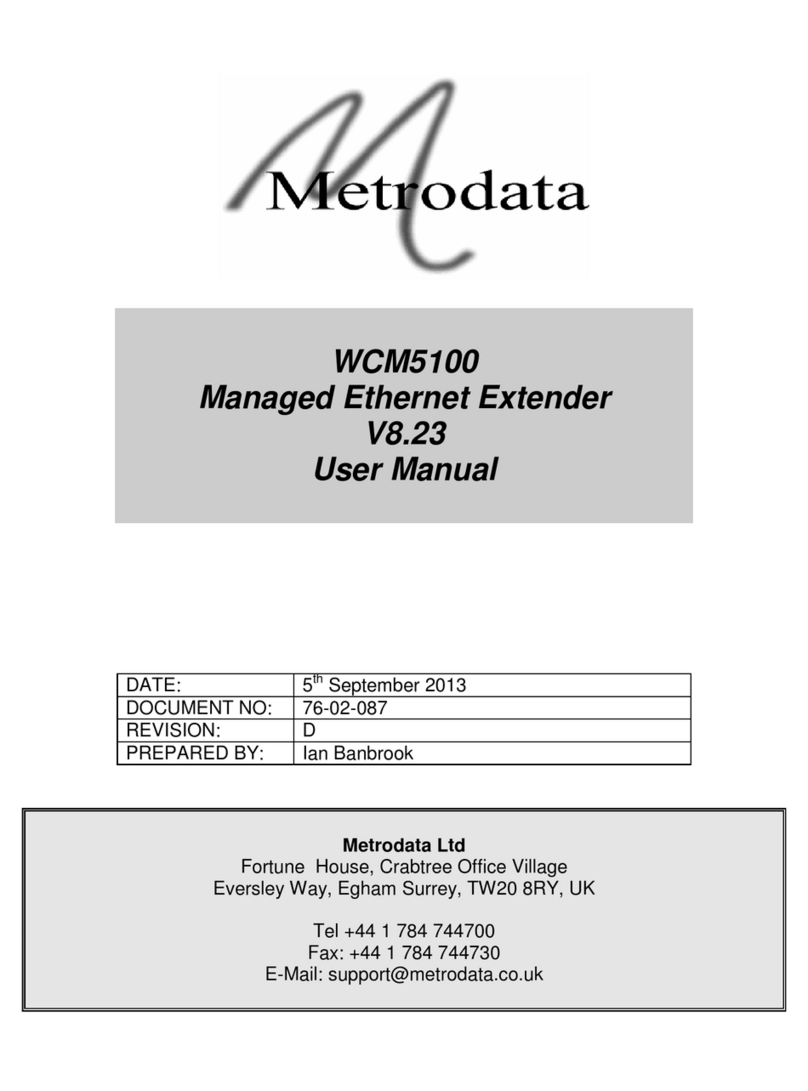
Metrodata
Metrodata WCM5100 User manual

Metrodata
Metrodata WCM5100 User manual

Metrodata
Metrodata MetroCONNECT WCM-Serial User manual

Metrodata
Metrodata WCM5100 User manual
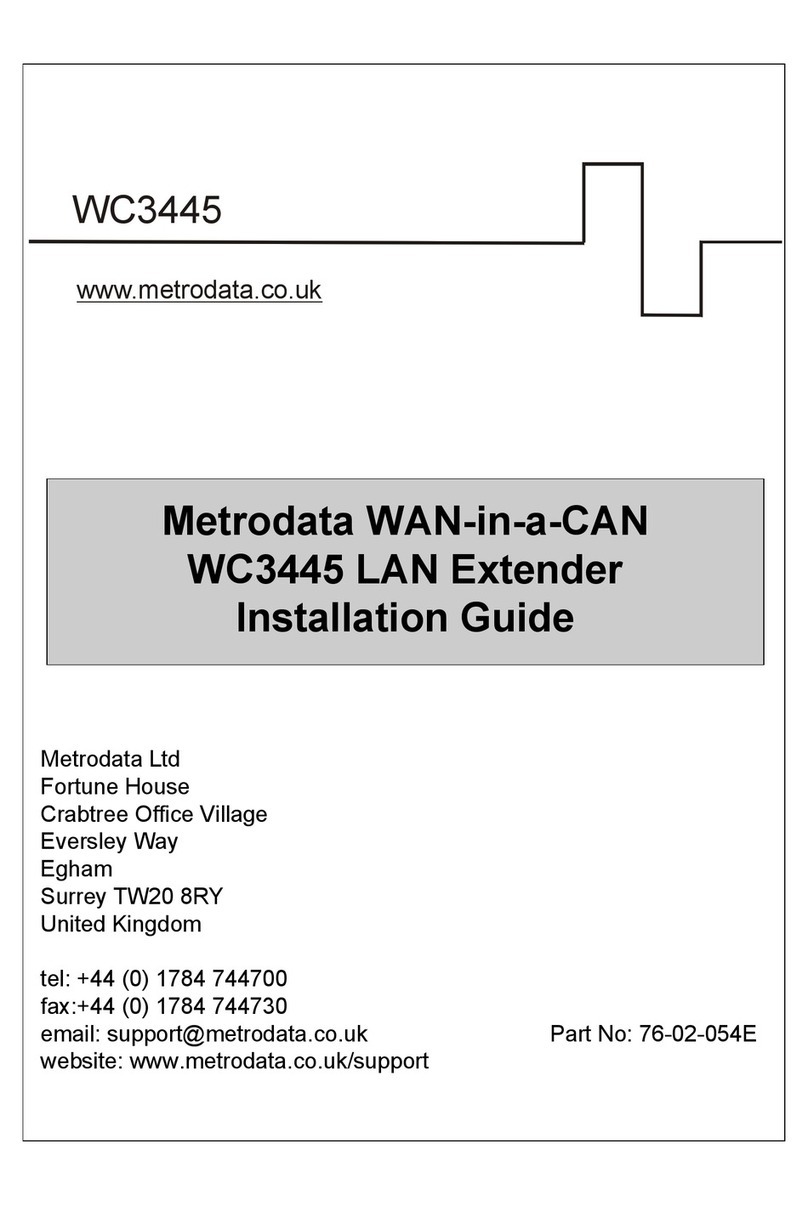
Metrodata
Metrodata WAN-in-a-CAN WC3445 User manual

Metrodata
Metrodata WCM5100 User manual
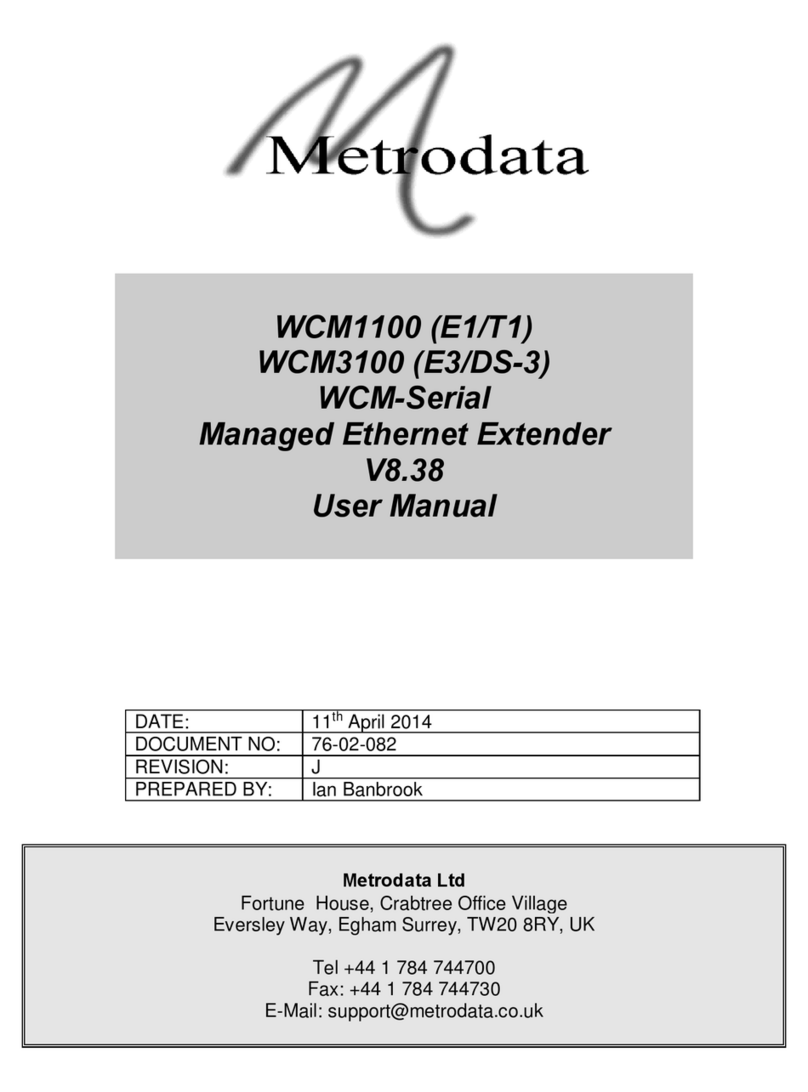
Metrodata
Metrodata WCM1100 User manual

Metrodata
Metrodata WCM1100 User manual
